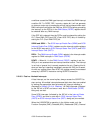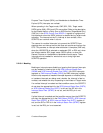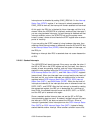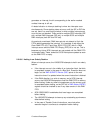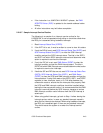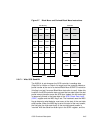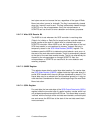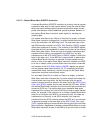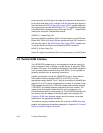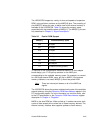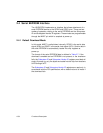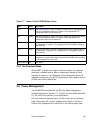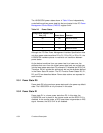SCSI Functional Description 2-47
2.2.17.5 Chained Block Move SCRIPTS Instruction
A chained Block Move SCRIPTS instruction is primarily used to transfer
consecutive data send or data receive blocks. Using the chained Block
Move instruction facilitates partial receive transfers and allows correct
partial send behavior without additional opcode overhead. Behavior of
the chained Block Move instruction varies slightly for sending and
receiving data.
For receive data (Data-In for initiator or Data-Out for target), a chained
Block Move instruction indicates that if a partial transfer occurred at the
end of the instruction, the WSR flag is set. The high-order byte of the
last SCSI transfer is stored in the SCSI Wide Residue (SWIDE) register
rather than transferred to memory. The contents of the SWIDE register
should be the first byte transferred to memory at the start of the chained
Block Move data stream. Since the byte count always represents data
transfers to/from memory (as opposed to the SCSI bus), the byte
transferred out of the SCSI Wide Residue (SWIDE) register is one of the
bytes in the byte count. If the WSR bit is cleared when a receive data
chained Block Move instruction is executed, the data transfer occurs
similar to that of the regular Block Move instruction. Whether the WSR
bit is set or cleared, when a normal block move instruction is executed,
the contents of the SCSI Wide Residue (SWIDE) register are ignored
and the transfer takes place normally. For “N” consecutive wide data
receive Block Move instructions, the 2nd through the Nth Block Move
instructions should be chained block moves.
For send data (Data-Out for initiator or Data-In for target), a chained
Block Move instruction indicates that if a partial transfer terminates the
chained block move instruction, the last low-order byte (the partial
memorytransfer)shouldbestoredinthelowerbyteoftheSCSI Output
Data Latch (SODL) register and not sent across the SCSI bus. Without
the chained Block Move instruction, the last low-order byte would be sent
across the SCSI bus. The starting byte count represents data bytes
transferred from memory but not to the SCSI bus when a partial transfer
exists. For example, if the instruction is an Initiator chained Block Move
Data Out of five bytes (and WSS is not previously set), five bytes are
transferred out of memory to the SCSI controller, four bytes are
transferred from the SCSI controller across the SCSI bus, and one byte
is temporarily stored in the lower byte of the SCSI Output Data Latch
(SODL) register waiting to be married with the first byte of the next Block
Move instruction. Regardless of whether a chained Block Move or normal
Block Move instruction is used, if the WSS bit is set at the start of a data



